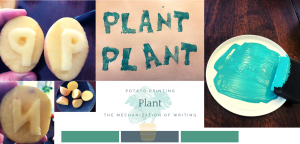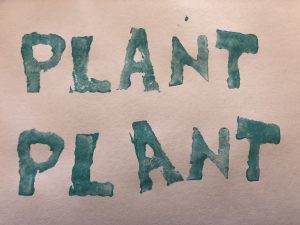
It is amazing to think of the history of print and how humans were able to not only invent alphabets as a means of recording ideas and information, but also innovate to mechanize the process of printing to allow for wide spread dissemination of information. Creating my potato stamps was a humbling experience, and I am almost embarrassed to admit that it was not until my fourth letter that I realized that I was carving my letters the wrong way. In order to create stamps the letters need to be backwards. Therefore, I had to redo my letter “P” and “L”. In my collage I show that the comparison between my two “Ps”, as I definitely found the backwards letters difficult to carve. “N” was particularly challenging. It took me about 40 minutes to complete this activity, and I did get better at carving out my letters with practice. However, I had thought that maybe I would do a sixth stamp and make a leaf, but by the time I finished my letters I was finished and did not want to make another stamp.
For the stamping, I decided to spread out the paint on a surface first and then place my potato stamp on it to pick up the paint before stamping. This was quite effective in distributing the paint somewhat evenly. I adopted this method based upon what I have seen in videos about printing presses. The hardest part about stamping my word was aligning the letters so that they were straight and to press down with right amount of pressure so that the paint was as light/dark as the other letters. As you can see, my two words are similar in orientation, but my “A” is very crooked in the second “plant” and a bit messy. The thickness of the paint on each letter completely varies.

Completing this activity definitely game me time to reflect not only on how important the invention of the Gutenberg’s printing press was in regards to paving the way for the mass production of print, but also the intricacies that were involved in creating this invention. From creating each individual die cast letter, the plates to assemble the letters to replicate the document backwards, and then the machine itself that allowed full pages to be stamped quickly and evenly. A remarkable invention!
